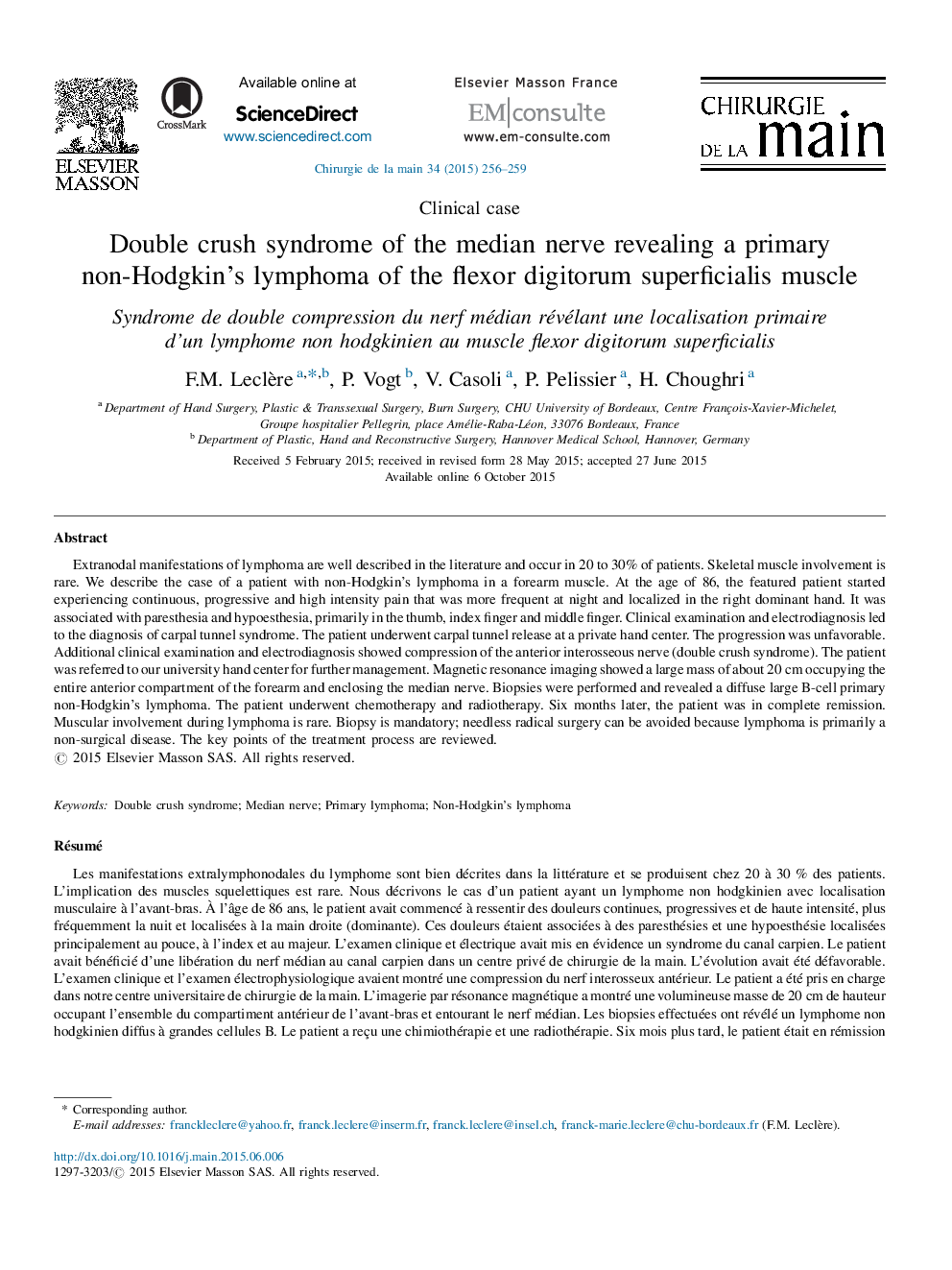| Article ID | Journal | Published Year | Pages | File Type |
|---|---|---|---|---|
| 4048612 | Chirurgie de la Main | 2015 | 4 Pages |
Extranodal manifestations of lymphoma are well described in the literature and occur in 20 to 30% of patients. Skeletal muscle involvement is rare. We describe the case of a patient with non-Hodgkin's lymphoma in a forearm muscle. At the age of 86, the featured patient started experiencing continuous, progressive and high intensity pain that was more frequent at night and localized in the right dominant hand. It was associated with paresthesia and hypoesthesia, primarily in the thumb, index finger and middle finger. Clinical examination and electrodiagnosis led to the diagnosis of carpal tunnel syndrome. The patient underwent carpal tunnel release at a private hand center. The progression was unfavorable. Additional clinical examination and electrodiagnosis showed compression of the anterior interosseous nerve (double crush syndrome). The patient was referred to our university hand center for further management. Magnetic resonance imaging showed a large mass of about 20 cm occupying the entire anterior compartment of the forearm and enclosing the median nerve. Biopsies were performed and revealed a diffuse large B-cell primary non-Hodgkin's lymphoma. The patient underwent chemotherapy and radiotherapy. Six months later, the patient was in complete remission. Muscular involvement during lymphoma is rare. Biopsy is mandatory; needless radical surgery can be avoided because lymphoma is primarily a non-surgical disease. The key points of the treatment process are reviewed.
RésuméLes manifestations extralymphonodales du lymphome sont bien décrites dans la littérature et se produisent chez 20 à 30 % des patients. L’implication des muscles squelettiques est rare. Nous décrivons le cas d’un patient ayant un lymphome non hodgkinien avec localisation musculaire à l’avant-bras. À l’âge de 86 ans, le patient avait commencé à ressentir des douleurs continues, progressives et de haute intensité, plus fréquemment la nuit et localisées à la main droite (dominante). Ces douleurs étaient associées à des paresthésies et une hypoesthésie localisées principalement au pouce, à l’index et au majeur. L’examen clinique et électrique avait mis en évidence un syndrome du canal carpien. Le patient avait bénéficié d’une libération du nerf médian au canal carpien dans un centre privé de chirurgie de la main. L’évolution avait été défavorable. L’examen clinique et l’examen électrophysiologique avaient montré une compression du nerf interosseux antérieur. Le patient a été pris en charge dans notre centre universitaire de chirurgie de la main. L’imagerie par résonance magnétique a montré une volumineuse masse de 20 cm de hauteur occupant l’ensemble du compartiment antérieur de l’avant-bras et entourant le nerf médian. Les biopsies effectuées ont révélé un lymphome non hodgkinien diffus à grandes cellules B. Le patient a reçu une chimiothérapie et une radiothérapie. Six mois plus tard, le patient était en rémission complète. La discussion revient sur les points clés de la prise en charge. La participation musculaire dans le cadre du lymphome est rare. La biopsie est obligatoire et permet d’éviter une chirurgie radicale inutile.
